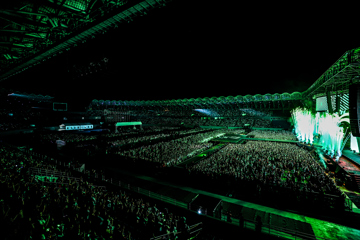Film Carew: The Hunger Games: Catching Fire, How I Live Now
Actress Jennifer Lawrence reprises her role as Catpiss, um, Katniss Everdeen in 'The Hunger Games: Catching Fire', which falls pretty flat.

You can do it, Catpiss!
For a film about catalogue-model-teenagers killing each other on television for sport, The Hunger Games went pretty light on the dystopian-near-future parable. The lore of the land was spelt out simply in a handful of intertitles, and the satire-of-reality-television stuff was merrily skimmed through en route to dropping virtuous Catpiss Katniss into the rote survival-movie battle royale of its televised thunderdome. The Hunger Games: Catching Fire does something slightly-sophisticated in comparison - please note: in comparison - by pulling back from the sport of running-man survival; it not a film about how legends are born, but how they're marketed.
After the heroic co-victory of Jennifer Lawrence and Josh Hutcherson in Season 74, they're back in their new roles as corporate shills; the ex-champs paraded about on an endless PR tour of local dustbowls and town-squares, their occupation to “be a distraction” as tools of Capitol (Kapital?) oppression. The fact that our main - and unbearably bland - couple are living their lives and love as extended pantomime serves as commentary on the inherent falsity of the reality-televised/status-update era; the pair enacting fiction until it becomes their reality. The couple's stage-managed affair comes with deft echoes of the Royal Wedding, and the pacification of the braying masses rests on whether Lawrence will can flip from killing-machine to playing pretty princess.
Where the first film took the Games at face value, Catching Fire ditches the arena for the boardroom; concerned with the machiavellian corporate machinations concocted by Donald Sutherland (in black leather gloves and Stalin beard, equal parts Shakesperean villain and starched-shirt Dean), Philip Seymour Hoffman (a lone island of casual naturalism in a film otherwise scared of reality), and Woody Harrelson (whose alcoholism is naught but yucks). Even when the game is on, there's the smell of Survivor in the air, the drama less about the cast getting voted off the tropical island (which is, in a pale re-write of Cube, really a giant booby-trapped clock), more about the politics of allegiances amongst its players. This time, they're not no-name teens fighting in some gladiatorial take on high-school social hierarchies, but name-brand champs engaged in a battle of wits; former winners brought back in a Top Chef All-Stars extravaganza prizing mind over might, the oldest reality-TV chestnut dusted off and served hot.
In turn, Lawrence and her cohorts (whose ranks include Amanda Plummer and Jeffrey Wright character-actin', and Jena Malone, whose eye-rollin' role comes with blessed self-mockery) aren't thinking inside the arena, but outside the box; not just wanting to survive, but bring down the whole system, man. Going beyond the Matrix marks a marked improvement on The Hunger Games; which is to say nothing of the fact that this time there's none of those stock-cliché moments in which some villain goes on a rambling “and now I'm going to kill you!” monologue whilst holding a knife to J-Law's jaw. But let's not quite get carried away with enshrining Catching Fire as anything other than a passable time-killer. This is still a film featuring Lenny Kravitz as a stylist whose signature is making clothes that catch on fire, a horde of CGI Killer Baboons written in solely for the tie-in video-game, and such profound philosophical witticisms as “love is weird.” And it's still a motion-picture-product that attempts to erect a critique of masses-opiating, market-tested corporate entertainments whilst being one and the same.
Don't miss a beat with our FREE daily newsletter

It's the end of the world as with know it, only this time with fucking-your-cousin. If every adolescent feels like the travails of first-love are earth-shattering stuff, How I Live Now literalises the sensation: with Saoirse Ronan and George MacKay, her real-life beau, boning in tasteful montage as kissin'-cousins in the apocalyptic English countryside. Ronan ditches her Irish lilt, playing a sneering American teen who, like a storybook orphan, arrives in a rambling, crumbling manor house filled with plentiful cousins but no adult figures. The film's opening half is shot in so many shades of sunkissed grassy-meadow romanticism, with director Kevin Macdonald making hand-held music-videos set to Nick Drake and Fairport Convention. The central dramatic arc, in this opening stanza, being that the American needs to get less neurotic, less medicated, more cousin-fuckin'.
Then some kind of attack takes place - “the terrorists!” - and not only do the kids now have no parents, but no internet! At first their ad-hoc family-unit stands strong, but then the film lurches into a tonally-jarring, awkwardly-judged second-half, of action-movie set-pieces and generic war-movie horrors. So, innocence is lost: first you pop your cherry, then you see piles of corpses. Fleeing across the countryside, the hope is theoretically for Ronan to be reunited with her beefcakin' cuz; and Macdonald - better known as pseudo-documentarian - now stages the drama as adolescent matinée. The two halves don't feel united, and the whole plays like failed enterprise: How I Live Now achieving neither the romantic resonance of a convincing love story, nor the political or symbolic sharpness of a near-future parable.







